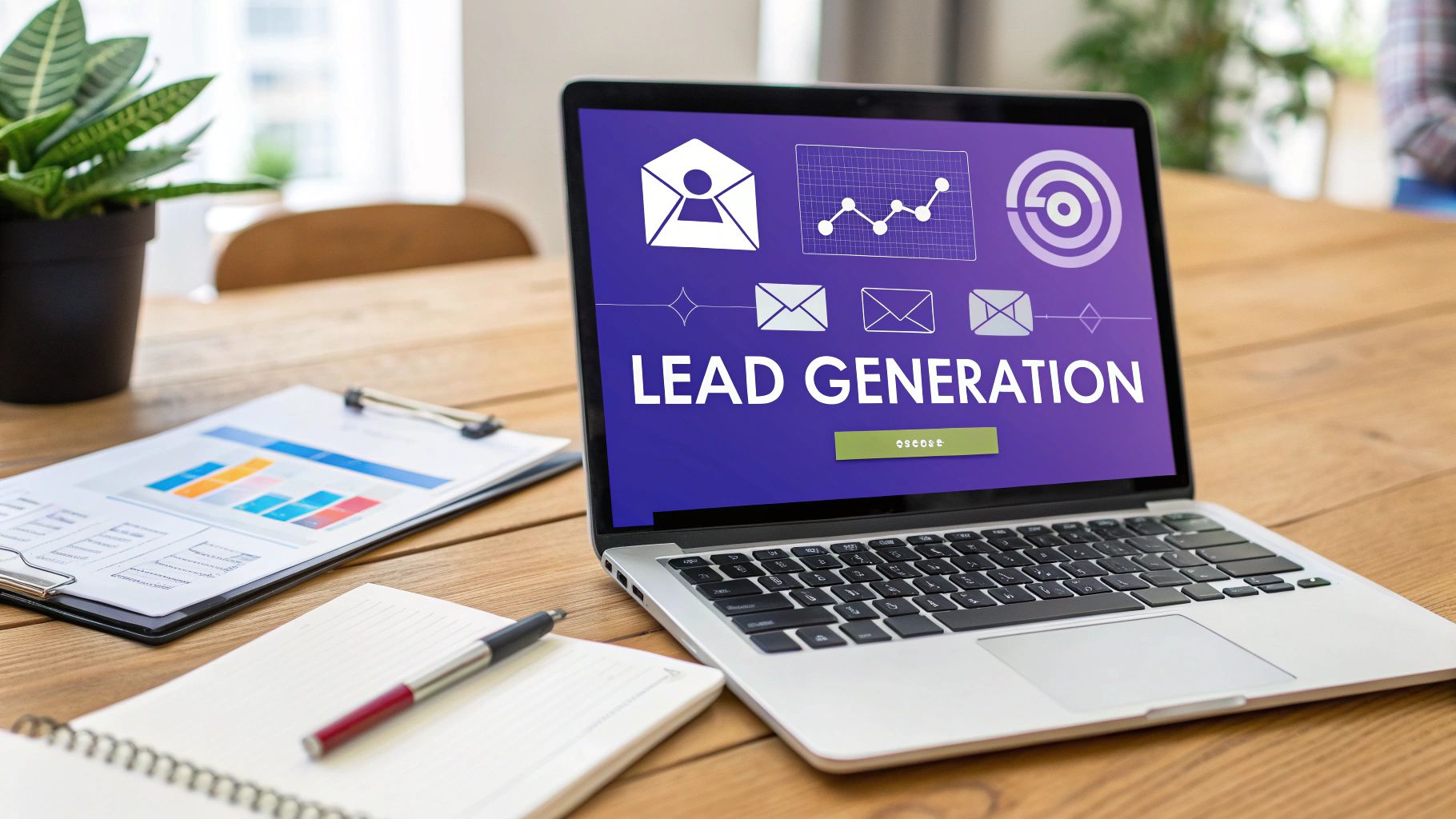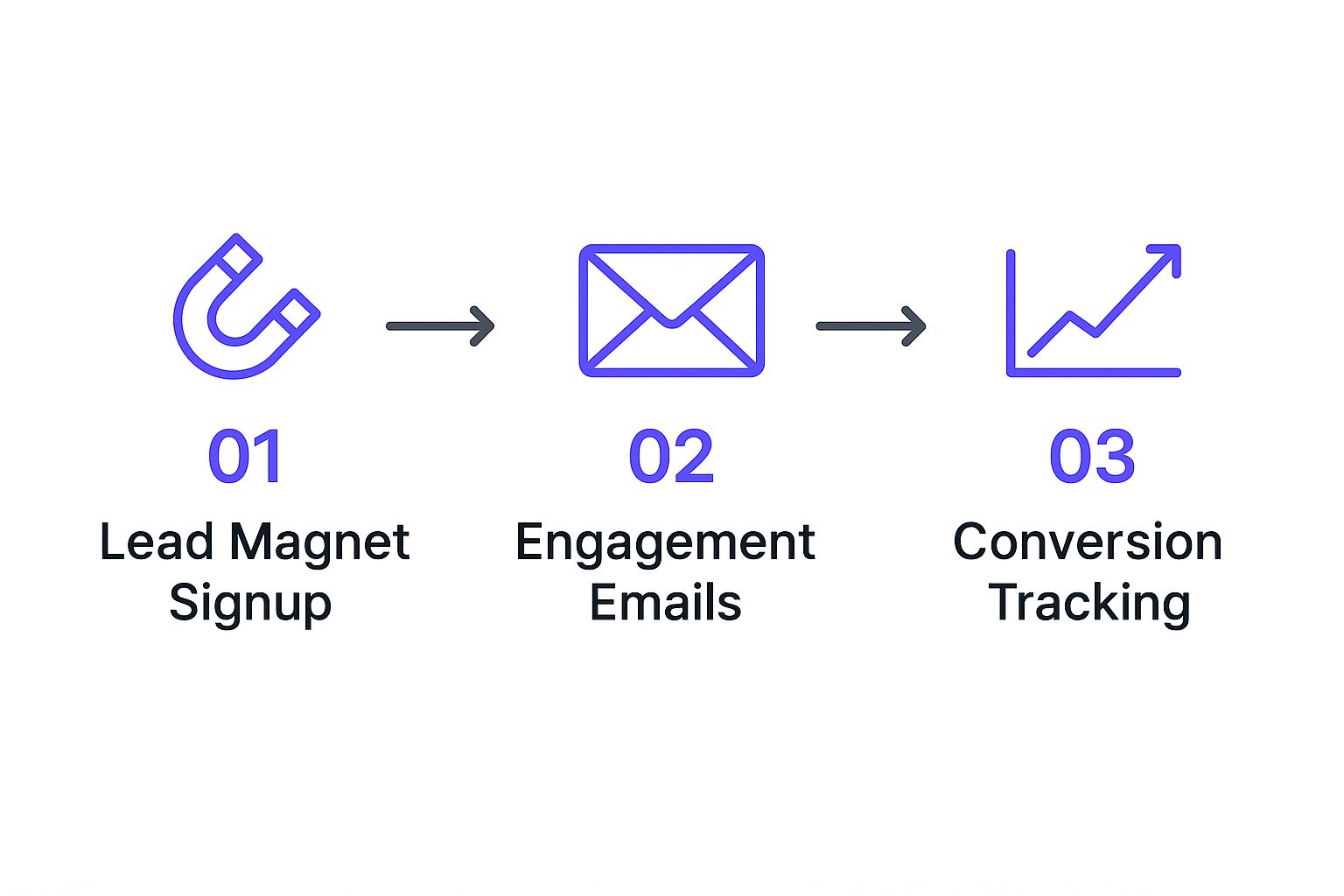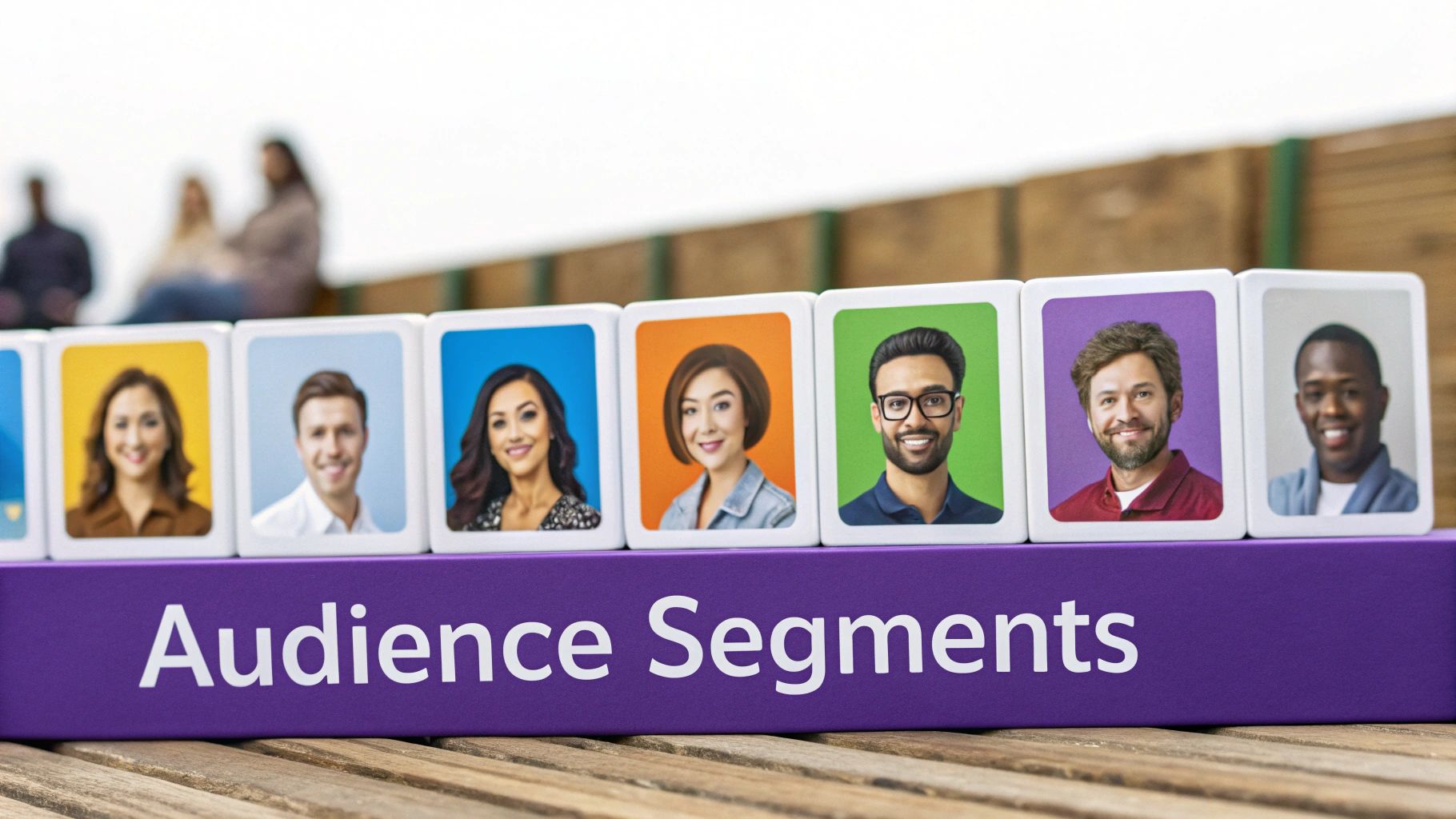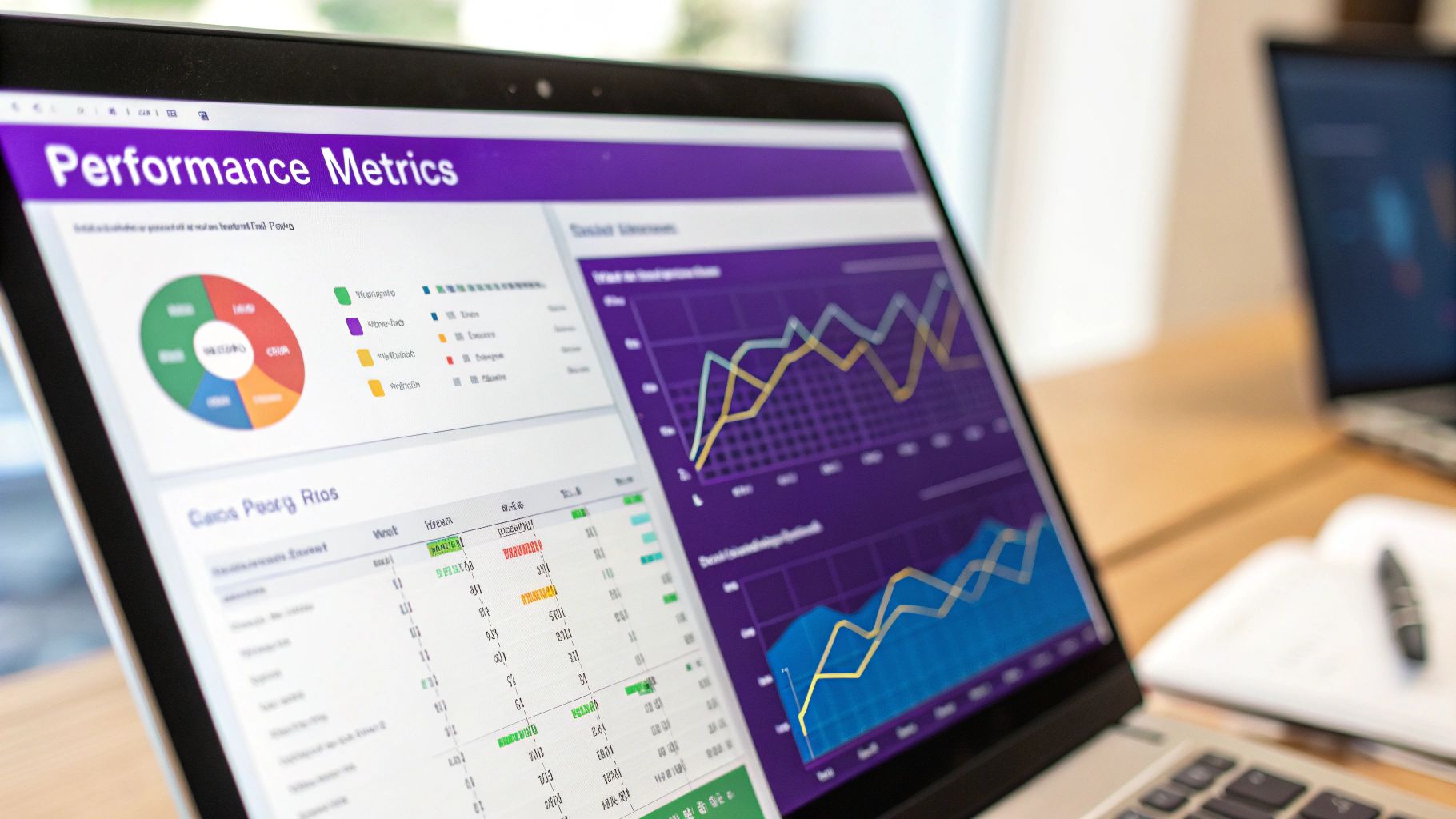Email Marketing and Lead Generation That Converts

Email marketing and lead generation isn't just about sending out newsletters. It's the strategic art of drawing in potential customers with something genuinely valuable and then using email to carefully build a relationship that, over time, guides them toward a purchase.
Think of it this way: relying on social media is like renting an audience. The algorithms are the landlord, and they can change the rules anytime. Building an email list? That's buying your own digital property. You own it, you control it, and you have a direct, reliable line to people who have explicitly asked to hear from you.
The Power of a Direct Line to Your Audience
This direct channel is the bedrock of sustainable growth. It lets you sidestep the unpredictable whims of social media and speak straight to people who are already interested in what you have to say. I've seen it time and time again: the most successful marketers know an email list isn't just a database of contacts. It’s a community you build, one trusted interaction at a time.
This isn't just about blasting promotions. It’s about cementing your authority and sparking real engagement, right in their inbox. This direct connection is what makes every other marketing action you take so much more effective.
Building a Foundation of Trust
At the heart of any great email lead generation strategy is a simple exchange of value. You offer something incredibly useful—a practical checklist, a deep-dive case study, an exclusive webinar—and in return, a potential customer gives you their email address. Don't underestimate this moment. It's not just a transaction; it’s the very beginning of a relationship.
This simple flow from initial interest to a measurable action is what it's all about.

As you can see, a single signup is the first step in a system designed to guide someone toward becoming a tracked, valuable conversion.
To help visualize this journey, let's break down the process into its core stages. Here's how a new contact moves through your email funnel, from the initial capture to the final conversion.
The Lead Generation Email Funnel at a Glance
Lead Capture: The primary goal at this stage is to attract potential customers and get them to subscribe. Key activities include creating compelling lead magnets (e.g., ebooks, templates, webinars) that are offered through signup forms.
Lead Nurturing: Here, the goal is to build trust, educate, and establish your authority. This is done by sending a welcome series, sharing valuable blog content, and offering case studies or success stories.
Lead Conversion: The final stage focuses on guiding qualified leads toward making a purchase. Key activities involve sending targeted offers, invitations to demos, exclusive discounts, or announcements for a free trial.
Each stage requires a different approach, but they all work together to move your audience from awareness to action in a natural, value-driven way.
Why Email Remains Unbeatable
With all the new channels popping up, why does email still dominate? The scale is simply massive. Around 4.6 billion people use email worldwide. That’s an incredible number, giving you the ability to connect with a huge, diverse audience across any industry or demographic you can think of.
The real power of email isn't just its reach, but its permission-based nature. Every subscriber has given you explicit consent to be in their inbox, making it one of the most qualified and receptive marketing channels available.
This consent is your green light to build a relationship founded on trust. It’s a direct line to your most engaged followers, creating a unique chance to deliver targeted, high-value content that truly resonates. To dig deeper into this, you can explore some powerful lead generation strategies through email marketing.
Building a List of High-Quality Leads

Let’s be honest: a massive email list doesn't mean a thing if it’s packed with people who never open your emails. The real aim of smart email marketing isn't just growing numbers; it's about attracting people who actually want to hear from you. This all starts with a compelling, value-packed offer.
Forget those generic "subscribe to our newsletter" pop-ups. They're tired, and they don't work well anymore. The best lead generation happens when you zero in on a specific problem for a specific group of people and offer them a real solution.
This is where your lead magnet enters the picture. It's a high-value resource you give away for free in exchange for an email address. The whole idea is to make the visitor feel like they're getting an absolute bargain. You're not just asking for their email; you're handing them a solution they can use right away.
Designing a Lead Magnet That Actually Converts
When I talk about lead magnets, people often picture a 50-page ebook. That’s not necessary. In my experience, the most effective lead magnets are super-targeted and easy to consume. Think about a small but nagging challenge your ideal customer is facing right now.
Here are a few ideas that I've seen deliver high-quality leads time and again:
- Targeted Checklists: A simple, step-by-step checklist is pure gold. Something like "The 10-Point Pre-Webinar Tech Check" is immediately useful and saves people time and headaches.
- Exclusive Case Studies: Offer a downloadable case study showing how a company just like theirs got a specific, impressive result. It’s powerful social proof that demonstrates what’s possible.
- Resource Toolkits: Put together a curated list of the best tools, templates, or resources your audience needs. This becomes a bookmark-worthy asset they’ll come back to.
The psychology here is pretty straightforward. You're showing off your expertise and being generous from the get-go. That builds instant trust and makes people far more likely to listen to what you have to say later. Once you truly understand your audience's pain points, creating a resource they’ll love becomes second nature. For more ideas on this, check out our guide to running a successful lead generation campaign.
The best lead magnets feel less like marketing and more like help. When you give away something truly valuable, you're not just capturing a lead—you're starting a relationship built on trust and expertise.
Where to Place Your Opt-ins (and How to Ask)
Once your killer lead magnet is ready, you need to put it where people will see it—without being obnoxious. A call-to-action placed thoughtfully within a relevant blog post or on a dedicated landing page will always outperform an aggressive, site-wide pop-up that interrupts the user experience.
Just as important is how you ask for that email. Regulations like GDPR and CCPA aren't just legal hoops to jump through; they represent best practices for building real trust. Be completely transparent about what people are signing up for, and for goodness sake, make the unsubscribe button easy to find.
Starting the relationship with respect is the only way to turn a new subscriber into a loyal, long-term customer. This focus on quality over sheer quantity is the secret sauce to sustainable lead generation.
Turning New Leads into Real Relationships
Getting that email address is just the first handshake. Now, the real conversation begins. This isn't about hitting them with a hard sell right out of the gate; it's about starting a relationship and showing them they made a smart choice. The best way to do that? A killer automated welcome sequence.
Your welcome emails are your first impression, and you only get one. They need to immediately deliver whatever you promised (like that ebook or checklist) and set the stage for what’s to come. Think of it as welcoming someone into your home—you want them to feel comfortable, valued, and excited to be there.
Your Welcome Sequence: A Simple Blueprint
A solid welcome sequence isn't just one "thanks for subscribing" email. It's a series of thoughtful messages that guide a new lead from being curious about you to being genuinely interested in what you have to say. Each email should build on the last, layering on value and personality.
Here’s a tried-and-true framework I’ve used for years:
Email 1 (The Welcome Mat - Sent Immediately): Get them what they asked for, fast. This email has one job: deliver the lead magnet. Keep it short, sweet, and focused on that one thing.
Email 2 (The "About Us" - Sent on Day 2): Now that they have their goodie, it's time to introduce yourself. Share your story. Why did you start your business? What’s your mission? People connect with people, not faceless brands.
Email 3 (The Value-Add - Sent on Day 4): Send them another piece of high-value content, no strings attached. This could be a link to your most popular blog post, a short video tutorial, or another helpful resource. It shows you're generous and reinforces your expertise.
This simple flow is a core part of effective email marketing and lead generation. It’s how you take a name on a list and turn it into an engaged fan.
The goal of a welcome sequence isn't to sell, but to serve. When you lead with value and personality, you're not just getting a subscriber; you're starting a relationship.
Smart Segmentation: Talking to People, Not a List
Let's be honest: not all leads are the same. Someone who signed up for a webinar on advanced marketing funnels is in a completely different place than someone who downloaded a beginner’s guide to social media. This is where segmentation becomes your superpower.
By "tagging" subscribers based on how they joined your list, you can send them content that actually matters to them. For example, you can create a specific follow-up sequence for everyone who downloaded a certain lead magnet. Suddenly, your emails feel less like a mass broadcast and more like a personal conversation. We dive deeper into this in our guide on how to generate leads with proven strategies that actually work.
This is more critical than ever, especially since so many people read emails on their phones. If your message isn't relevant and easy to read on a small screen, it’s getting deleted. Responsive design is non-negotiable. When you combine smart segmentation with a mobile-first approach, your emails don’t just land in the inbox—they get opened, read, and valued.
Turning Nurtured Leads Into Customers

Moving a lead from the nurturing phase to the sales conversation is where the real magic happens. It's a delicate balance, though. If you push for the sale too soon, you can easily shatter the trust you've worked so hard to build. But if you wait too long, their interest might fade, and you'll miss your window.
The trick is learning to spot the buying signals hidden in your email analytics.
Think of these signals as digital body language. When a subscriber starts clicking on links to a specific product page over and over, or if they visit your pricing page multiple times, they're practically raising their hand. These actions are your green light to pivot from educational content to something more direct.
Crafting Emails That Convert
When a lead signals they're ready, it's time to adjust your messaging. This isn't about sending a generic, hard-sell pitch. Instead, you want to frame your offer as the natural next step on their journey to solving a problem. The whole point is to make saying "yes" feel like the most obvious, helpful decision they could make.
What does this look like in practice?
A live demo or a highly targeted webinar can be incredibly effective. Instead of just listing features, you’re showing a solution in action. An email with the subject "Live Q&A: Finally Overcome [Specific Pain Point]" is far more enticing than a bland "Request a Demo."
Likewise, a strategically timed special offer can be the perfect nudge for a warm lead. A personalized discount code based on the products they've been eyeing shows you're paying attention and makes them feel valued.
The best conversion emails don't feel like a sales pitch at all. They feel like a helpful, perfectly timed solution to a problem the lead has already told you they have.
Writing Copy That Inspires Action
The words you choose now are more critical than ever. Your subject line is the gatekeeper—it has to be compelling enough to earn the open. Ditch the vague promises and get specific. Instead of "Special Offer Inside," try something like, "Your Personal Invite to Our [Product] Masterclass." It feels exclusive and benefit-driven.
Your call-to-action (CTA) needs that same clarity and energy. Forget generic buttons like "Click Here" or "Submit." You need action-oriented language that tells the subscriber exactly what will happen next.
Here are a few CTA examples that work:
- Book Your Personalized Demo
- Claim Your 20% Discount Now
- Save My Spot for the Webinar
Once you've done the work of nurturing your leads, the final step is turning that interest into revenue. It's smart to explore some proven tactics to close more leads to sharpen your closing strategy. This powerful combination of smart copywriting and strategic offers is what makes email marketing and lead generation a true engine for business growth.
Measuring What Matters to Drive Growth
Data is your best friend in email marketing, but let's be honest—not all data is created equal. Chasing a high open rate feels good, but it doesn’t pay the bills. If you want your email marketing to be a genuine growth engine, you have to look past those surface-level numbers and focus on what actually drives leads and revenue.
The real question isn't, "How many people opened my email?" It's, "How many people took the action I wanted them to take?" That shift in thinking is what turns a passive email list into a powerful lead-generating machine.
Focus on Actionable KPIs
To get a real sense of your campaign's health, you need to be almost religious about tracking the metrics that show genuine subscriber engagement and intent. These numbers tell you if your content is hitting the mark and guiding people toward becoming customers.
Here are the core metrics I never take my eyes off of:
- Click-Through Rate (CTR): This is your first real sign of life. It shows how many people found your email compelling enough to actually click a link. A healthy CTR means your message and call-to-action are resonating.
- Conversion Rate: This is the big one—the ultimate measure of success. It tracks the percentage of people who did the thing you asked them to do, whether that was downloading a guide, booking a demo, or buying a product.
- List Churn Rate: You need to know how many subscribers you're losing. A high churn rate is a major red flag, often signaling that your content is missing the mark or you're simply emailing too often.
Keeping a close eye on these KPIs gives you a clear, data-backed picture of what’s working and what’s not. For an even deeper dive into measurement, our guide on measuring event ROI has some fantastic frameworks you can adapt for your email campaigns.
Create a Continuous Feedback Loop
The single most powerful way to improve your metrics is to build a system of continuous A/B testing. It's a simple concept: you make small, controlled changes to see what your audience responds to best, creating a feedback loop that sharpens your strategy over time.
The key is to not test everything at once. You need clean data, so isolate one variable at a time. Pit two subject lines against each other to see which one earns more opens. Or, test two different calls-to-action to see which one inspires more clicks.
The goal of A/B testing isn't just to find a single "winner." It's about developing a repeatable system for understanding your audience, making smarter decisions, and incrementally improving your entire email marketing funnel.
The opportunity here is massive. With the global email user base projected to hit 4.83 billion people and grow to 5.61 billion soon, standing out is only getting harder. Optimizing your approach isn't just a good idea; it's essential for survival. You can dig into more stats on this trend over at CloudHQ's blog.
And remember, data tells only part of the story. Pairing your marketing metrics with direct customer insights is where the magic happens. Learning to implement effective customer feedback strategies will give you the qualitative "why" behind the numbers, helping you refine your campaigns for long-term success.
Frequently Asked Questions

As you get your hands dirty with email marketing and lead generation, you're bound to run into a few common questions. I've heard them all over the years, and getting the answers right from the start can be the difference between a campaign that fizzles out and one that really takes off. Let's tackle some of the most frequent ones.
How Often Should I Email My List for Lead Nurturing?
Ah, the million-dollar question. The honest answer? It depends. There’s no single magic number that works for everyone. The right email frequency comes down to your audience, your industry, and how much genuine value you can consistently offer.
A weekly, content-rich newsletter is a pretty solid starting point for most businesses. But for a brand-new lead? You'll probably want to hit their inbox every 2-3 days during that first week. This helps you build crucial momentum and trust right out of the gate.
The real key is finding that sweet spot between consistency and value. You have to keep a close eye on your engagement metrics.
If your open rates start to dip or your unsubscribe rate suddenly spikes, that’s a huge red flag. It’s your audience telling you to ease up. Always prioritize quality over quantity; one truly valuable email a month is infinitely better than four weekly updates that say nothing at all.
What Is the Difference Between a Lead Magnet and a Nurture Campaign?
It's easy to get these two mixed up, but they play very different roles. The best way to think about them is as two connected but distinct steps in your customer's journey.
A lead magnet is the bait. It’s that irresistible, high-value offer that convinces someone to give you their email address. Think checklists, ebooks, or a webinar registration. Its one and only job is to capture the lead.
A nurture campaign is what happens next. It’s the series of automated emails designed to build a real relationship. This is where you provide even more value, establish your authority, and gently guide that new lead toward becoming a customer. The lead magnet gets them in the door; the nurture campaign convinces them to stick around and, eventually, to buy.
What Are the Most Important Metrics to Track for Lead Generation?
It's so tempting to get fixated on open rates, but honestly, they don't tell you much. To really understand if your emails are working, you need to track the numbers that connect directly to your business goals.
Here are the metrics I live and die by for lead generation:
- Conversion Rate: This is your north star. It’s the percentage of people who actually did the thing you wanted them to do, whether that’s signing up for a demo or making a purchase.
- Click-Through Rate (CTR): This tells you how many people were engaged enough by your email to actually click a link. It's a fantastic indicator of genuine interest.
- List Growth Rate: Is your list actually growing with qualified people? This metric shows you if your lead capture strategy is healthy and working.
- Unsubscribe Rate: A high rate here can be a painful but necessary signal that there's a mismatch between your content and what your audience wants.
Watching these specific numbers gives you a clear, actionable picture of what’s working and what isn’t.
Can I Buy an Email List to Speed Up Lead Generation?
Let me be blunt: No. Buying an email list is a tempting shortcut that almost always backfires. It can cause serious, long-term damage to your business.
Think about it—those contacts never asked to hear from you, which makes every email you send unsolicited spam. This path leads to disastrously low open rates, sky-high complaint rates, and can even get your domain blacklisted by email providers. Worse, it destroys your brand’s reputation and violates data privacy laws like GDPR and CAN-SPAM.
Building your list organically with valuable lead magnets and permission-based sign-ups is the only way to do it right. It takes more work, but it's the only sustainable path to success.
Turning your speaking gigs into a reliable stream of high-quality leads shouldn't be a headache. With SpeakerStacks, you can launch a branded, mobile-friendly landing page in under 90 seconds, complete with a unique QR code for your audience. They can instantly grab your resources, book a meeting, or subscribe to your list—turning fleeting attention into a measurable pipeline.
Ready to see how simple it can be? Find out how to start capturing and converting leads from every single presentation at https://speakerstacks.com.